
Cyril M. Kornbluth was an American science fiction author and a member of the Futurians. He used a variety of pen-names, including Cecil Corwin, S. D. Gottesman, Edward J. Bellin, Kenneth Falconer, Walter C. Davies, Simon Eisner, Jordan Park, Arthur Cooke, Paul Dennis Lavond, and Scott Mariner.
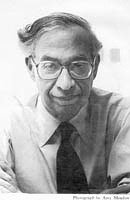
Donald Allen Wollheim was an American science fiction editor, publisher, writer, and fan. As an author, he published under his own name as well as under pseudonyms, including David Grinnell, Martin Pearson, and Darrell G. Raynor. A founding member of the Futurians, he was a leading influence on science fiction development and fandom in the 20th-century United States. Ursula K. Le Guin called Wollheim "the tough, reliable editor of Ace Books, in the Late Pulpalignean Era, 1966 and '67", which is when he published her first two novels in Ace Double editions.
The Futurians were a group of science fiction fans, many of whom became editors and writers as well. The Futurians were based in New York City and were a major force in the development of science fiction writing and science fiction fandom in the years 1937–1945.

Isaac Asimov was an American writer and professor of biochemistry at Boston University. During his lifetime, Asimov was considered one of the "Big Three" science fiction writers, along with Robert A. Heinlein and Arthur C. Clarke. A prolific writer, he wrote or edited more than 500 books. He also wrote an estimated 90,000 letters and postcards. Best known for his hard science fiction, Asimov also wrote mysteries and fantasy, as well as popular science and other non-fiction.

Stanley Grauman Weinbaum was an American science fiction writer. His first story, "A Martian Odyssey", was published to great acclaim in July 1934; the alien Tweel was arguably the first character to satisfy John W. Campbell's challenge: "Write me a creature who thinks as well as a man, or better than a man, but not like a man." Weinbaum wrote more short stories and a few novels, but died from lung cancer less than a year and a half later.
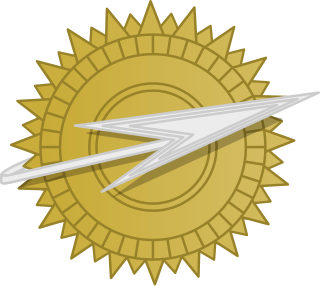
The Galactic Empire is an interstellar empire featured in Isaac Asimov's Robot, Galactic Empire, and Foundation series. The Empire is spread across the Milky Way galaxy and consists of almost 25 million planets settled exclusively by humans. For over 12 millennia the seat of imperial authority was located on the ecumenopolis of Trantor, whose population exceeded 40 billion, until it was sacked in the year 12,328. The official symbol of the empire is the Spaceship-and-Sun. Cleon II was the last Emperor to hold significant authority. The fall of the empire, modelled on the fall of the Roman Empire, is the subject of many of Asimov's novels.
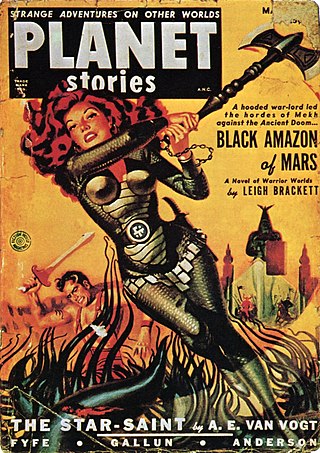
Planet Stories was an American pulp science fiction magazine, published by Fiction House between 1939 and 1955. It featured interplanetary adventures, both in space and on some other planets, and was initially focused on a young readership. Malcolm Reiss was editor or editor-in-chief for all of its 71 issues. Planet Stories was launched at the same time as Planet Comics, the success of which probably helped to fund the early issues of Planet Stories. Planet Stories did not pay well enough to regularly attract the leading science fiction writers of the day, but occasionally obtained work from well-known authors, including Isaac Asimov and Clifford D. Simak. In 1952 Planet Stories published Philip K. Dick's first sale, and printed four more of his stories over the next three years.
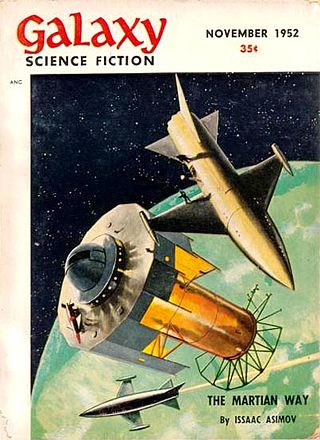
The Martian Way is a science fiction novella by American writer Isaac Asimov. It was first published in the November 1952 issue of Galaxy Science Fiction and reprinted in the collections The Martian Way and Other Stories (1955), The Best of Isaac Asimov (1973), and Robot Dreams (1986). It was also included in The Science Fiction Hall of Fame, Volume Two (1973) after being voted one of the best novellas up to 1965.

"A Rose for Ecclesiastes" is a science fiction short story by American author Roger Zelazny, first published in the November 1963 issue of The Magazine of Fantasy and Science Fiction with a special wraparound cover painting by Hannes Bok. It was nominated for the 1964 Hugo Award for Short Fiction.
"The Callistan Menace" is a science fiction short story by American writer Isaac Asimov. It first appeared in the April 1940 issue of Astonishing Stories and was reprinted in the 1972 collection The Early Asimov. It was the second science fiction story written by Asimov, and the oldest story of his still in existence.

"A Martian Odyssey" is a science fiction short story by American writer Stanley G. Weinbaum originally published in the July 1934 issue of Wonder Stories. It was Weinbaum's second published story, and remains his best known. It was followed four months later by a sequel, "Valley of Dreams". These are the only stories by Weinbaum set on Mars.

"Omnilingual" is a science fiction short story by American writer H. Beam Piper. Originally published in the February 1957 issue of Astounding Science Fiction, it focuses on the problem of archaeology on an alien culture.
"Half-Breed" is a science fiction short story by American writer Isaac Asimov. It was first published in the February 1940 issue of Astonishing Stories and reprinted in the 1972 collection The Early Asimov. It was the fifteenth story written by Asimov, and the fourth to be published. At 9000 words, it was his longest published story to date.
Astonishing Stories was an American pulp science fiction magazine, published by Popular Publications between 1940 and 1943. It was founded under Popular's "Fictioneers" imprint, which paid lower rates than Popular's other magazines. The magazine's first editor was Frederik Pohl, who also edited a companion publication, Super Science Stories. After nine issues Pohl was replaced by Alden H. Norton, who subsequently rehired Pohl as an assistant. The budget for Astonishing was very low, which made it difficult to acquire good fiction, but through his membership in the Futurians, a group of young science fiction fans and aspiring writers, Pohl was able to find material to fill the early issues. The magazine was successful, and Pohl was able to increase his pay rates slightly within a year. He managed to obtain stories by writers who subsequently became very well known, such as Isaac Asimov and Robert Heinlein. After Pohl entered the army in early 1943, wartime paper shortages led Popular to cease publication of Astonishing. The final issue was dated April of that year.
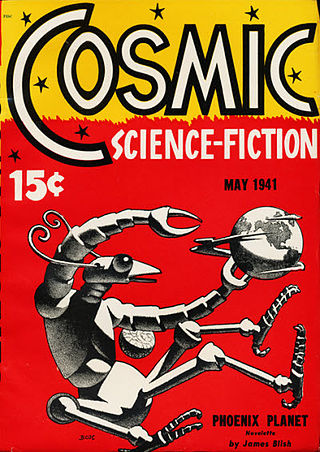
Cosmic Stories and Stirring Science Stories were two American pulp science fiction magazines that published a total of seven issues in 1941 and 1942. Both Cosmic and Stirring were edited by Donald A. Wollheim and launched by the same publisher, appearing in alternate months. Wollheim had no budget at all for fiction, so he solicited stories from his friends among the Futurians, a group of young science fiction fans including James Blish and C. M. Kornbluth. Isaac Asimov contributed a story, but later insisted on payment after hearing that F. Orlin Tremaine, the editor of the competing science fiction magazine Comet, was irate at the idea of a magazine that might "siphon readership from magazines that paid", and thought that authors who contributed should be blacklisted. Kornbluth was the most prolific contributor, under several pseudonyms; one of his stories, "Thirteen O'Clock", published under the pseudonym "Cecil Corwin", was very successful, and helped to make his reputation in the field. The magazines ceased publication in late 1941, but Wollheim was able to find a publisher for one further issue of Stirring Science Stories in March 1942 before war restrictions forced it to close again.

Comet was a pulp magazine which published five issues from December 1940 to July 1941. It was edited by F. Orlin Tremaine, who had edited Astounding Stories, one of the leaders of the science fiction magazine field, for several years in the mid-1930s. Tremaine paid one cent per word, which was higher than some of the competing magazines, but the publisher, H-K Publications based in Springfield, MA, was unable to sustain the magazine while it gained circulation, and it was cancelled after less than a year when Tremaine resigned. Comet published fiction by several well-known and popular writers, including E.E. Smith and Robert Moore Williams. The young Isaac Asimov, visiting Tremaine in Comet's offices, was alarmed when Tremaine asserted that anyone who gave stories to competing magazines for no pay should be blacklisted; Asimov promptly insisted that Donald Wollheim, to whom he had given a free story, should make him a token payment so he could say he had been paid.
"The Weapon" is a science fiction short story by American writer Isaac Asimov. Written in September 1938 when Asimov was 18, it was first published in the May 1942 issue of Super Science Stories under a pseudonym, H.B. Ogden. Because of the pseudonym, Asimov forgot that this story had ever been published and so, assuming that it had been rejected and believing that he no longer had a copy of it, he omitted it from The Early Asimov (1972), a collection of his earliest stories. In that book he listed "The Weapon" among eleven of his short stories that had been lost forever. However, while writing the first volume of his autobiography, In Memory Yet Green (1979), Asimov came across an entry in his diary which reminded him that the story had indeed been published. Obtaining a copy of the relevant magazine, he ensured that the story was published in chapter 30 of that book.
This is a bibliography of American science fiction author Kim Stanley Robinson.
The year 1950 was marked, in science fiction, by the following events.
The year 1955 was marked, in science fiction, by the following events.












